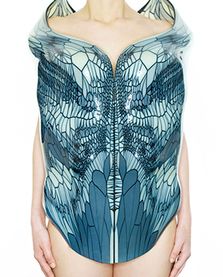Utilizing Materials Science with Neri Oxman
|
Amazing advances have been made using 3D printers. We are now able to input data and create a specified design for artificial limbs, living organs, food, buildings materials, and much more. One pioneer in this field who experiments with different materials, structural and digital designs, and fabrication technology is Neri Oxman. She is an architect and sculpture who is currently a faculty member in the MIT Media Lab. She has collaborated with experts in many fields to create her works of art including material scientists, fashion designers, mathematicians, engineers, and computer scientists. Each piece she creates is inspired by structures found in nature and is an engineering masterpiece whose research and construction has many practical applications.
|
This piece titled "Arache" in her Imaginary Beings series, is based on the idea of the strength and flexibility of spider webs to create flexible body armor. According to her description, the design of the web, as well as the density and thickness of each cell, are determined by the anatomy of the core body. "The areas where the corset covers the ribs, the web is filled with stiff cells for shielding bony tissue; in areas where the corset covers the inter-costal muscles, the web is filled with softer, more flexible cells, providing for muscular flexibility to enhance and augment movement within the chest wall" (Oxman, 2014). By using a variety of components based on their material properties, Oxman was able to create an item fitted to the contours, comfort and movement of the human body that has applications in actual body armor.
The video above shows another piece created by Oxman titled "Gemini". It was created to be a lounge chair designed to create a quiet and comforting setting that conveys the relationship of twins in the womb. A lot of engineering and thought went into the overall design, shape and architecture of the chair itself. It is also lined with a layer of 3D printed material meant to absorb and diffuse sound. Along with her collaborator, she used different fabrication materials of various rigidities and colors to fit this layer to the contours of the chair. They used 44 composite digital materials and experimented with special designs. The orb shapes are meant to diffuse the sound waves and the soft materials used to make them are absorptive, so sound is dampened when sitting in it. "The materials, shapes and surfaces of the 3D printed skin enable a
unique vibrational acoustic effect for a quiet calming environment" (Stratasys, 2014).
For more information: http://neri.media.mit.edu/
For more information: http://neri.media.mit.edu/



